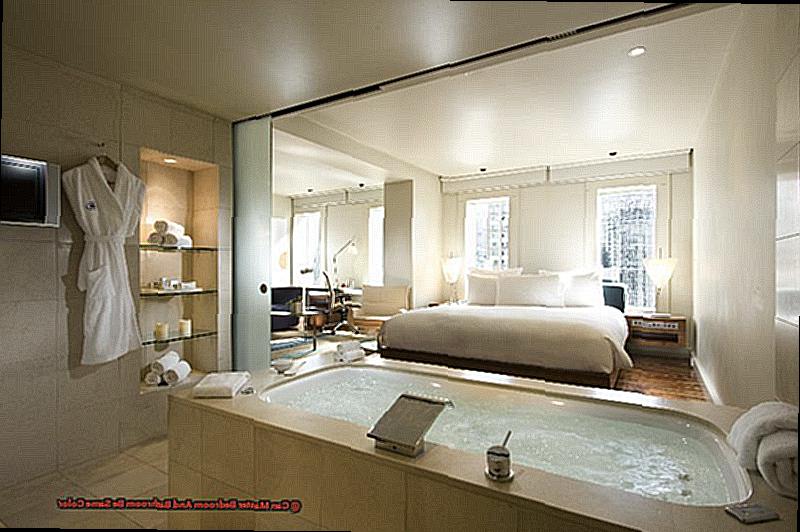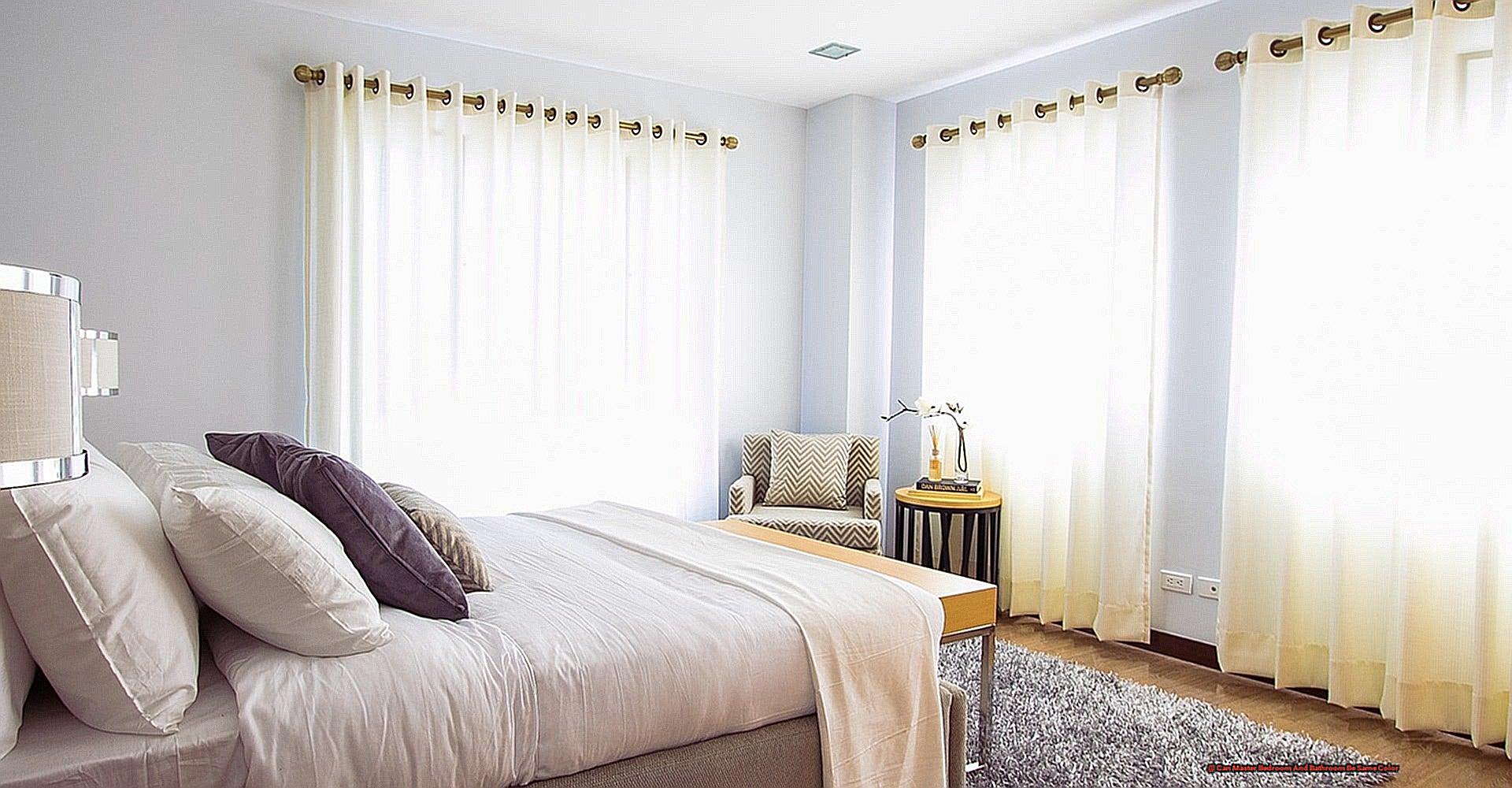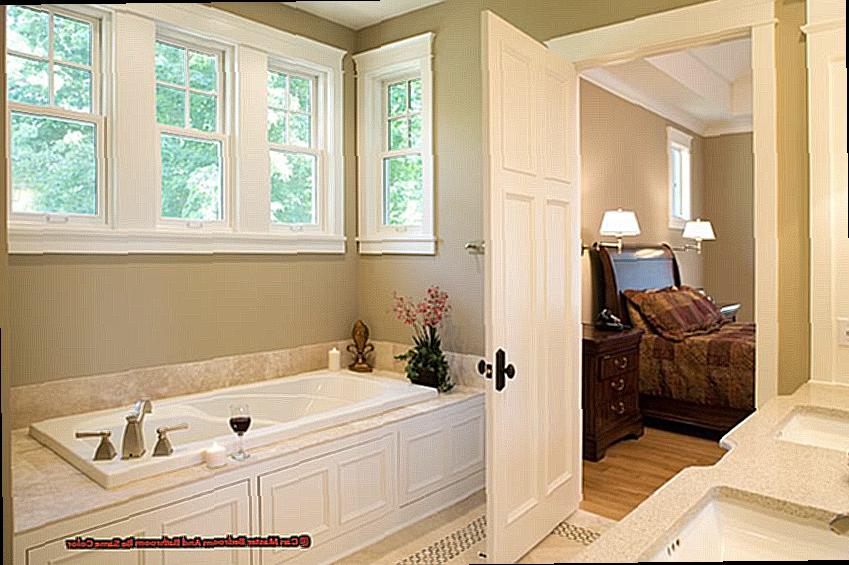Are you tired of the endless search for the perfect color scheme for your master bedroom and bathroom? Do you find yourself overwhelmed with the task of coordinating different colors and patterns? Look no further, because we have a solution that may simplify your design process without compromising style.
Imagine walking into your master suite and feeling a sense of harmony and cohesion between your bedroom and bathroom. By using the same color in both spaces, you can achieve this desired effect effortlessly. No more stressing over finding complementary colors or worrying about clashing designs – everything will seamlessly flow together.
But wait, won’t it be dull to have the same color in two rooms? Not at all. With some creative thinking and strategic use of accents, you can infuse personality and uniqueness into each space. Think of it as a blank canvas ready to be adorned with different textures, patterns, and accessories.
Not only does this approach create a cohesive look, but it also has practical benefits. Using the same color can make smaller spaces feel larger and more open. It also allows for an easy transition from one room to the other, creating a seamless flow within your master suite.
So, why not consider using the same color for your master bedroom and bathroom? It may just be the design hack you’ve been waiting for. Keep reading to discover some tips on how to successfully execute this idea and elevate your home’s aesthetic with this simple yet effective technique.
Contents
- 1 What color should you not paint a bathroom?
- 2 What color should master bedroom be?
- 3 What color is for bathroom?
- 4 What is the bedroom color for sleeping?
- 5 Is grey color good for master bedroom?
- 6 How can I coordinate my bathroom and bedroom colors?
- 7 Does your bathroom have to match the rest of your house?
- 8 Should bathroom be warm or cool colors?
- 9 Can you mix warm and cool colors in a bathroom?
- 10 How many colors can you have in a bathroom?
- 11 Conclusion
What color should you not paint a bathroom?
When it comes to selecting a color for your bathroom, there are certain hues that should be steered clear of in order to achieve a harmonious and aesthetically pleasing atmosphere. These include olive greens and golden browns, black, peach, and green.
| Colors | Why it should be avoided |
| Olive greens and golden browns | These shades can give the bathroom a drab and outdated appearance, and may not complement the white fixtures and tiles commonly found in bathrooms. |
| Black | Black can create a feeling of darkness and confinement in the bathroom, especially in smaller spaces. It is also notorious for making watermarks and stains more noticeable. |
| Peach | Incorporating peach into the bathroom can clash with the white fixtures and tiles, resulting in an unbalanced or jarring visual effect. |
| Green | Green can lend a sickly or moldy look to the bathroom, making it an unideal color choice for this area. |
Ultimately, the color you choose for your bathroom will ultimately depend on your personal preferences and the unique characteristics of your space.
What color should master bedroom be?
Choosing the ideal color for your master bedroom can be an enjoyable and exhilarating journey. It’s vital to take into account the overall feeling and ambiance you want to create in the room, as well as your personal preferences. Here are some steps you can follow to help you select the perfect color for your master bedroom:
- Determine the desired atmosphere: Consider if you want your master bedroom to exude a light and airy vibe or a dark and cozy one. This will serve as a guide when choosing colors.
- Reflect on the mood: Think about the type of mood you want to set in your bedroom. Do you desire a serene and peaceful space or a glamorous and daring one? This will also influence your color choices.
- Choose between solid or patterned colors: Solid colors can create an illusion of more space, while patterns can add visual interest. Keep in mind that certain colors and patterns may make a room appear larger or smaller.
- Experiment with different shades: Don’t be afraid to play around with different shades within a color family. For instance, blue-gray, celery tones, or layering white paint with all-white furniture and linens can produce a calming atmosphere.
- Create a moodboard: To get a better sense of how colors will complement each other, create a moodboard using paint samples, fabric swatches, and other materials.
- Utilize color psychology: Certain colors can have a psychological impact on our moods. For example, green can help us unwind and relax, while pink evokes feelings of love and care. Consider incorporating these colors in your master bedroom.
- Follow the 60-30-10 rule: Divide the colors in your room into percentages – 60% dominant color, 30% secondary color, and 10% accent color. This will help create a harmonious and unified appearance.

What color is for bathroom?
When it comes to choosing the perfect color for your bathroom, there are several important factors you should take into consideration. Not only should your chosen color showcase your unique sense of style and preferences, but it should also create a soothing and welcoming ambiance. To assist you in determining the ideal color for your bathroom, here are some helpful tips to keep in mind:
- Begin with the Color Wheel: Utilizing the color wheel can be an invaluable tool when it comes to selecting a color scheme for any room, including your bathroom. It can help you identify complementary colors or monochromatic palettes that will harmonize well together.
- Stick to Three Colors: Once you have a general idea of the color palette you want to use, try to limit yourself to three colors. This will aid in creating balance and prevent the space from feeling overwhelming.
- Mix Two Neutrals: Neutrals are an excellent way to add depth and harmony to your bathroom. Consider blending two neutral shades, such as beige and gray, for a sophisticated appearance.
- Adhere to the Rule of Three: The rule of three suggests that utilizing three different shades of the same color can produce a cohesive and visually pleasing design. For instance, consider using light, medium, and dark shades of blue for a calming and tranquil bathroom.
- Don’t Fear Dark Colors: While lighter shades may make your bathroom appear more spacious, don’t be afraid to experiment with darker hues. Dark colors can lend drama and elegance to the space.
- Contrast Two Bold Tones: If you wish to incorporate a pop of color into your bathroom, contemplate using two bright shades that contrast with one another, such as yellow and purple or green and pink.
- Embrace Nature: Infusing natural elements into your bathroom can create a serene and spa-like atmosphere. Consider adding plants or incorporating earthy tones like greens and browns.
- Balance Vibrant Choices with a Neutral: If you want to incorporate vibrant or playful colors into your bathroom, balance them out with a neutral shade. This will help prevent the room from feeling too chaotic.
- Test Paint Swatches at Home: Before committing to a specific color, it’s essential to see how it looks in your bathroom. Bring home paint swatches and hold them up to the walls to see how they will appear in different lighting.

By following these suggestions, you can determine the perfect color for your bathroom that not only reflects your personal style but also creates a tranquil and inviting space.
What is the bedroom color for sleeping?
The color of your bedroom can have a significant impact on your sleep, affecting your mood, energy levels, and ability to fall and stay asleep. It is imperative to choose colors that promote relaxation and tranquility in the bedroom in order to create an ideal sleep environment.
How does the color of your bedroom affect your sleep?
When it comes to creating a peaceful and relaxing bedroom environment, the choice of color plays a crucial role. The colors you select can greatly influence your mood, energy levels, and quality of sleep. In this section, we will explore how the color of your bedroom affects your sleep and provide tips for choosing the perfect color.
The Science Behind Color and Sleep:
Before delving into specific colors, it is important to understand the science behind how color affects our sleep. Our bodies have an internal clock called the circadian rhythm, which regulates our sleep-wake cycle. This clock is greatly influenced by light, especially natural light. Exposure to light suppresses the production of melatonin, a hormone that induces sleepiness. This is why we tend to feel more alert during the day when exposed to natural light and more drowsy at night when it is dark.
When selecting colors for your bedroom, it is crucial to keep this in mind. Bright and stimulating colors like red, orange, and yellow can disrupt our circadian rhythm and make it challenging to fall asleep. On the other hand, dark colors such as black or navy blue can create a somber atmosphere that may lead to feelings of depression or anxiety.
Best Bedroom Colors for Sleep:
What is the bedroom color for sleeping? While personal preferences may vary, there are a few colors that are generally considered most conducive for sleep:
- Blue: Blue is often regarded as the best color for sleep due to its calming and soothing effect on the mind and body. It is also associated with feelings of trust, security, and stability.
- Green: Similar to blue, green has a relaxing effect on the mind and promotes a sense of tranquility. It is also associated with nature, making it an excellent choice for creating a peaceful environment in your bedroom.
- Lavender: Shades of purple, particularly light lavender, have been found to induce relaxation and improve sleep quality. It is also a great option for those who want a touch of color in their bedroom without it being too overwhelming.
- White: White is often associated with cleanliness and purity, making it a popular color choice for bedrooms. It also reflects light well, creating a bright and airy feel in the room.
- Gray: A neutral color like gray can create a serene and calm atmosphere in the bedroom. It is also versatile and can be easily paired with other colors for added visual interest.
Is grey color good for master bedroom?
When it comes to choosing the primary color for your master bedroom and bathroom, gray is definitely an option to consider. However, before making a decision, it is important to carefully weigh the pros and cons as the color of a room can greatly impact its overall ambiance and functionality.
Pros:
- Gray is a versatile color that can work wonders in any room, at any time, for any occasion.
- It can exude both warmth and coolness, darkness and lightness, making it suitable for various design styles.
- Gray offers endless possibilities for creative expression by allowing you to play with different accent colors and experiment with accessories and decor.
- In a primary bathroom, gray can create a sleek and modern look while maintaining a cozy and welcoming feel.
- Light shades of gray can visually expand small spaces when combined with natural light through skylights or windows.
- Gray pairs beautifully with various textures, such as wood or stone, adding depth and dimension to the room.
Cons:
- Overuse of gray can make a room feel cold or sterile if not balanced with warmer elements.
- Using the same shade of gray on walls, floors, and fixtures may result in an overly monochromatic look.
- Careful consideration must be taken when choosing the right shade of gray to avoid it looking too bland or too bold.
- In a master bedroom, too much gray may not promote a relaxing or restful atmosphere. It is important to balance it out with calming colors like blue or green for better sleep.
- In a bathroom, dark shades of gray may make the space feel smaller and less inviting. Opting for lighter shades can create a spacious and open feel.
Overall, using gray as the primary color for your master bedroom and bathroom has its share of advantages and disadvantages. It is crucial to plan carefully and strike a balance between this color and other elements in the room to create an aesthetically pleasing and inviting space.
How can I coordinate my bathroom and bedroom colors?
Start by creating a color palette. Before selecting specific shades for your bedroom and bathroom, decide on a color scheme that you want to work with. This will help you narrow down your options and guarantee that the colors complement each other.
Take into account the size and layout of the rooms. Keep in mind the dimensions and arrangement of your bedroom and bathroom when choosing coordinating colors. Lighter shades can make a small room feel more spacious, while darker shades can add warmth to a larger room.
Incorporate accent colors for a more dynamic look. To avoid a monotonous appearance, consider using accent colors in one room that complement the main color in the other room. For example, if your bedroom walls are a light blue, you can use navy blue towels or accessories in the bathroom.
Consider lighting as it greatly impacts color perception. Take into account both natural and artificial lighting when selecting coordinating colors for your bedroom and bathroom.
Stick to a similar color temperature for a cohesive look. Choose colors with similar undertones to create a cohesive aesthetic. For instance, if your bedroom has cool-toned gray walls, opt for a cool-toned shade for your bathroom as well.
Select different finishes to distinguish between rooms while maintaining a cohesive color scheme. Use matte paint in the bedroom and glossy or semi-glossy paint in the bathroom, for example.
Incorporate textures and patterns to tie the two rooms together. Instead of solely relying on paint color, consider incorporating textures and patterns through items such as rugs, curtains, or bedding.
Find inspiration from various sources. If you’re struggling to decide on coordinating colors, seek inspiration from home decor magazines or websites. You can also draw inspiration from nature or your favorite artwork.
Test out paint samples before committing to painting the entire room. Once you have narrowed down your choices, test out samples on the walls to see how they look in different lighting. This will help you make a final decision and ensure that you are satisfied with the color choice.
Does your bathroom have to match the rest of your house?
In reality, having a divergent color scheme can enhance visual appeal and give your bathroom its own distinct personality.
While some individuals may prefer a consistent color scheme throughout their home, others may want to play with different colors and themes in their bathroom. Ultimately, it comes down to personal preference and the overall style and design of your home.
However, if you do want to create a cohesive look throughout your home, there are ways to achieve this without having identical color schemes in each room. Consider using a timeless design or similar colors with unique fixtures and accessories in your bathroom. This will tie in with the rest of your home while still allowing for some variation and room for creativity.
On the other hand, if you desire each room in your home to have its own distinct personality, feel free to utilize different colors and themes in your bathroom. This will add visual interest and allow you to express your personal style.
Should bathroom be warm or cool colors?
When it comes to choosing the right color for your bathroom, the debate between warm and cool colors has been ongoing.
Each color option brings its own unique benefits to the table. On one hand, using warm colors such as reds, oranges, and yellows can create a cozy and inviting atmosphere, perfect for when you want to relax in the tub after a long day.
However, the drawback of warm colors is that they can sometimes feel overwhelming or too energizing, making it difficult to unwind. On the other hand, cool colors like blues, greens, and purples can create a calming and relaxing environment, ideal for a spa-like experience.
But if not balanced properly, cool colors can also make a bathroom feel too cold and sterile. So how do you strike the perfect balance?
For a master bedroom and bathroom that are painted the same color, a neutral or monochromatic color palette can create a cohesive and serene look. This allows you to play with different shades and tones of the same color without overpowering the room.
Ultimately, it all comes down to personal preference and finding the right balance between cozy and calming
Can you mix warm and cool colors in a bathroom?
It is possible to achieve a harmonious and aesthetically pleasing bathroom design by combining both warm and cool colors. However, there are a few key elements that must be taken into account, including the overall color scheme, the size and style of the bathroom, and the lighting.
Achieving the perfect balance between warm and cool colors is crucial, as well as establishing a dominant color scheme to bring the entire space together. With careful thought and experimentation, it is entirely feasible to incorporate both warm and cool colors into your bathroom design for a stunning result.
One essential factor to consider when mixing warm and cool colors in a bathroom is the overall color scheme. It is crucial to choose colors that complement each other and create a cohesive look. For example, pairing warm earthy tones with cool blues or greens can create a calming and balanced atmosphere.
Additionally, the size of the bathroom should also be taken into account when selecting colors. In smaller bathrooms, it may be best to stick with lighter shades to avoid overwhelming the space.
Furthermore, the style of the bathroom should also be considered when incorporating both warm and cool colors. For a modern or minimalist look, using a dominant color scheme with subtle pops of warm or cool tones can create a sleek and sophisticated design. In contrast, for a more traditional or eclectic style, mixing warm and cool colors in equal proportions can add depth and personality to the space.
Lastly, lighting plays a crucial role in achieving a successful balance between warm and cool colors in a bathroom. Natural light can bring out the true tones of each color, so it is essential to consider how much natural light your bathroom receives.
In spaces with limited natural light, using artificial lighting strategically can help enhance the warmth or coolness of certain colors.
How many colors can you have in a bathroom?
The amount of colors you can use in a bathroom to match the color scheme of your master bedroom is not limited.
But it is crucial to use colors thoughtfully and purposefully in order to avoid an overwhelming or mismatched design.
Conclusion
In conclusion, the master bedroom and bathroom can indeed be the same color, providing a cohesive and harmonious look while simplifying the design process. This approach allows for an easy transition between spaces and offers endless possibilities for creative expression.
When selecting colors for your master suite, it is important to consider factors such as desired atmosphere, mood, and color psychology. Utilizing the 60-30-10 rule can also help in choosing the perfect color scheme. However, there are certain hues that should be avoided in the bathroom, such as olive greens, golden browns, black, peach, and green.
For the master bedroom, balance is key when using a single color throughout the space. It is recommended to incorporate accents and textures to add personality and uniqueness. When it comes to bathroom color schemes, sticking to three colors and balancing vibrant choices with neutrals is crucial. Some recommended options include blue, green, lavender, white, and versatile gray.
Gray may not be a traditional choice for a master bedroom color but when balanced correctly with other elements in the room, it can create a sophisticated and calming atmosphere. Its versatility allows for various design styles – from modern to classic – making it a great option for any home.
In conclusion, whether or not you choose to use gray in your master suite will ultimately depend on your personal preferences.






